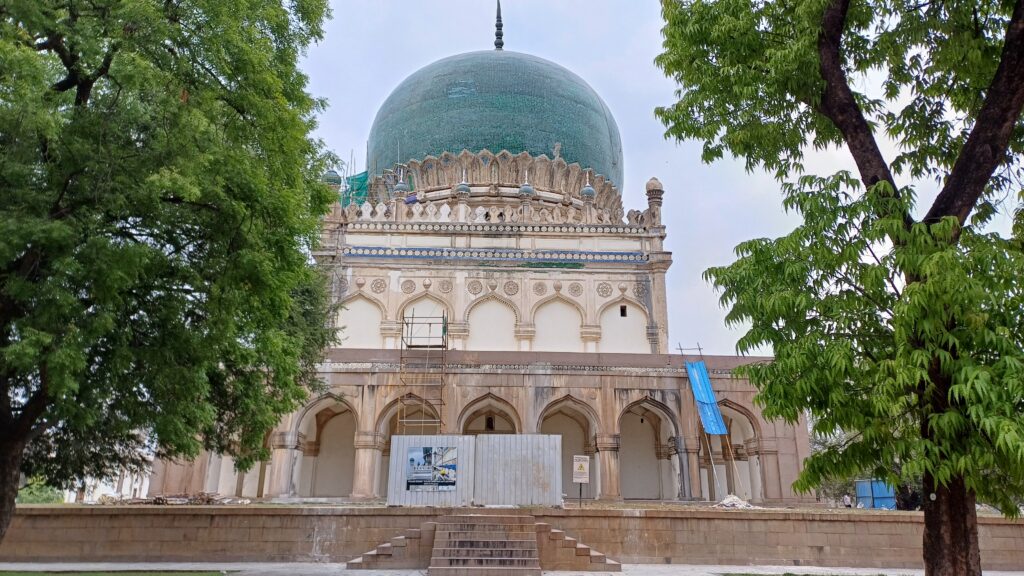The ongoing restoration of the 15th-century tomb of Muhammad Qutb Shah in Hyderabad, with its distinctive green, glazed dome and intricate tile work, has thrown open a great opportunity to reintroduce and preserve the art of tile work from that era, potentially leading to a revival of the once-lost craft.
With an estimated 2 lakh handmade tiles of various colours, apart from the complex stucco work, the final resting place of the sixth ruler of the Qutb Shahi dynasty of the Deccan is among the most beautiful tombs. Its restoration work is also expected to be time-consuming.
Muhammad Qutb Shah was the nephew and son-in-law of the founder of Hyderabad, Muhammad Quli Qutb Shah. Born in 1593, he ruled as the Sultan of Golconda from 1612 until he died in 1626.
“When we started to work on this building, we discovered the evidence of tile work under the cement cover that was part of the conservation efforts in the 20th century. It has taken us six to seven years to get here… This is the only place (at the Qutb Shahi Heritage Park) where we found tile work on the dome. The conservation is 100 per cent based on in-situ evidence,” Ratish Nanda, the CEO of Aga Khan Trust for Culture (AKTC), tells indianexpress.com.
 According to Nanda, there is archival evidence to suggest tile work on Muhammad Quli Qutb Shah’s tomb but no in-situ evidence was found when the 20th-century cement cover on the dome was removed.
According to Nanda, there is archival evidence to suggest tile work on Muhammad Quli Qutb Shah’s tomb but no in-situ evidence was found when the 20th-century cement cover on the dome was removed.
AKTC is carrying out the work in collaboration with the Department of Heritage, Telangana. The conservation effort of Muhammad Qutb Shah’s mausoleum is funded by IndiGo Reach and InterGlobe Foundation.
According to Nanda, there is archival evidence to suggest tile work on Muhammad Quli Qutb Shah’s tomb but no in-situ evidence was found when the 20th-century cement cover on the dome was removed. “In this case, we found old fragments of tiles. So conservation is not about making something look better but ensuring the original’s authenticity is maintained,” he says.
“We found tile patterns, we found out it was all green, we could find the exact pattern, exact colour, which is why the restoration was possible,” Nanda adds, pointing out that the new tiles have been matched exactly to the physical and chemical properties of the original tiles found on the building.
Story continues below this ad
While placing green tiles on the dome, a task that was completed in July 2024, was easier, Nanda explains that the tile work on the minarets and the facade is more intricate. “This is like a mosaic. We have to break tiles into different shapes and match them, which can mean that we have to fix 50 tiles in the same space. You see such tile work all across the world but this craft has been lost world over.”
 The original craft of tile work comes from central Asia where there were buildings that did not have access to stone.
The original craft of tile work comes from central Asia where there were buildings that did not have access to stone.
The original craft of tile work comes from central Asia where there were buildings that did not have access to stone. The builders in medieval central Asia used tile as a waterproof mechanism to protect the bricks from rain. “They were also beautiful and very attractive. It was used in all parts of the Muslim world – from Turkey to India. Because it was not an essential craft and with machine-made tiles available, the craft of making handmade tiles died out many years ago. Each of these 2 lakh tiles is glazed twice, which means it goes into the kiln twice,” explains Nanda. And because they are all handmade, there are variations in colour shade with the slightest temperature change, making it even more beautiful.
For the AKTC and Nanda, the restoration of this tile work allows a peek into the Qutb Shahi times and a better understanding of their architecture. While the tile work on the tomb has been progressing for two years now, the most intricate work on the facade and the minarets is now being done and will take another few months to complete.
© The Indian Express Pvt Ltd



